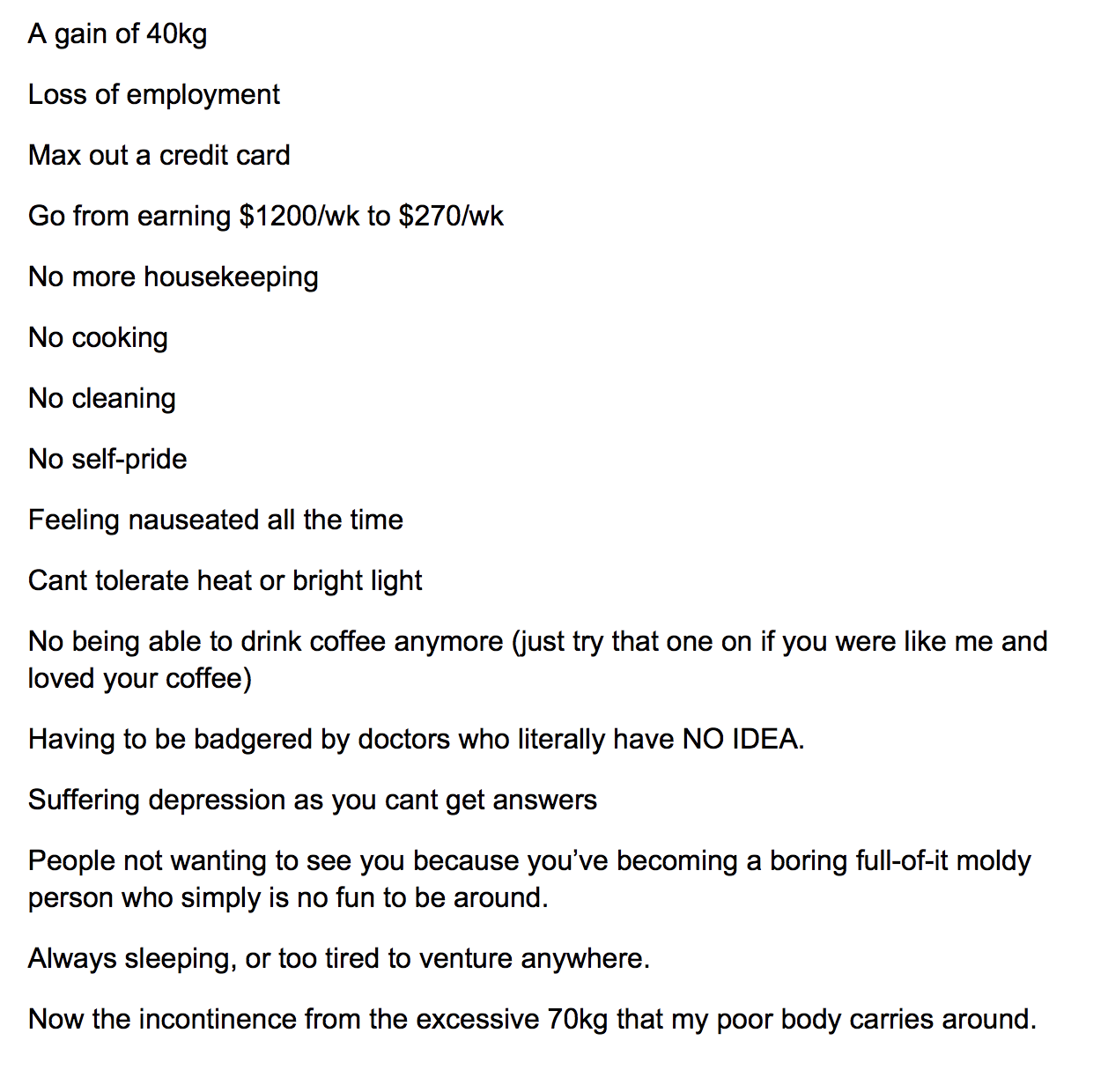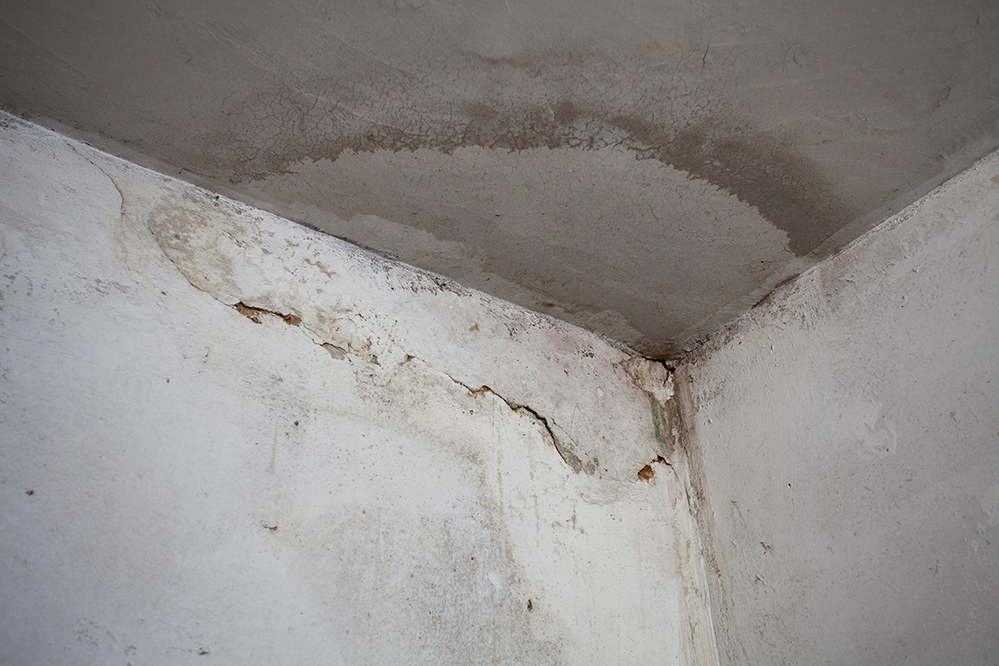Monica's* symptoms include fatigue, "brain fog", headaches, muscle pain and weakness, weight gain and joint pain.
She thought they were part of aging, but then she read about an illness called Chronic Inflammatory Response Syndrome (CIRS), also known as mould illness or biotoxin-related illness. Now she believes her health issues come from exposure to household mould.
Monica is one of more than 100 people who made a submission to a federal parliamentary inquiry set up to investigate CIRS. The committee reported back last week.
Queenslander Barbara wrote about moving into a leaky home with her family in 2014, with her symptoms increasing after a severe storm. “Now I am so sensitive to the effects of active mould I have been referred to as ‘The Canary in the Mine’,” she wrote.
She says she is unable to work, hold a conversation, or “show interest in anything”.
One anonymous submission read: "I have been stripped of who I am/was: almost all of my tastes, preferences, activities, delights, interests etc. can no longer be accommodated."
"I can’t do much anymore," wrote another. "I am mostly housebound, but I make sure I go out once each day for an hour or two. Our nanny takes our children on all outings … I never take our children anywhere by myself anymore."
The submissions tell of years-long struggles with complex symptoms affecting multiple bodily systems that witnesses believe stem from exposure to mould or water-damaged buildings; difficulties with doctors disbelieving them, and then diagnosing them with psychological symptoms rather than treating their physical symptoms; and spending large amounts of money on treatment and moving house.

Witnesses described how the symptoms had taken over and changed their lives.
Symptoms described as being associated with CIRS include memory and concentration problems, disorientation, insomnia, gastrointestinal issues, light sensitivity, static shocks, metallic taste, sinus issues, fever and respiratory issues. CIRS advocates say sufferers will generally have some combination of these and other symptoms over a long period of time.
The submissions described the isolation caused by debilitating symptoms. One Western Australian resident said they had "had little social interaction since 2012", resulting in "moderate to extreme loneliness".
"Numerous friends abandoned their friendships with me because I was not able to initiate contact or organise or participate in gatherings. It tested the levels of compassion and empathy and generosity of the people in my life and sadly the result was that most of them moved on with their lives without me in it."
A grandmother who had been living in Parkes in regional NSW said her life went from “living in a small country town, friendly people, close to family, with a brand new granddaughter, making new friends, had a brilliant job and enjoying my hobbies” to:

Witnesses said they struggled to find sympathetic doctors who believed them, and that they thought that doctors often didn’t know about the possible health impacts of mould.
The scientific and medical community generally does not accept the claims of CIRS advocates. The health department told the inquiry that the scientific evidence was "not sufficient ... to accept the assertion that exposure to environmental biotoxins" such as mould caused CIRS.
The Royal Australiasian College of Physicians agreed it was not a recognised disease, saying that "inappropriate labels can mislead efforts to improve the health and wellbeing of people with symptoms" and preferring to refer to patients as people with "multiple not-readily-explained symptoms".
Zara said she consulted three GPs, five medical specialists, two naturopaths and a biologist to figure out the cause of her symptoms.
“The attitude of doctors towards me when I told them I had a mould-related illness was very unhelpful and sceptical,” she wrote. “I was ostracised and the lack of consensus, understanding and support was extremely distressing ... At a time in my life when I so desperately needed to be understood, nurtured and supported I felt completely alone.”
Nicole, who now sleeps in a tent after she says her water-damaged apartment made her ill, said she had been "ignored, belittled ... and dismissed because they are not aware of what this illness does so therefore I must be mentally ill. The ignorance and arrogance has prolonged my suffering and pain”.

They also told stories of the financial burden.
In many submissions people described being unable to work due to their symptoms, and living off Centrelink payments. Others tallied up the amount they had spent on relocation, getting rid of mould, and medical treatment.
One 49-year-old Brisbane woman, who said she has been sick for 18 years, estimates she has spent over $250,000 in that period.
Janice put the cost of selling her house, buying another and making appropriate modifications as having “easily exceeded” $100,000.
Maree said she had to leave her “beautiful” home in Melbourne’s eastern suburbs, where mould illness had left her unable to tolerate the pollution, and is now building a mould-free home in Grantville, Victoria. “This illness has cost me hundreds of thousands of dollars in relocation, remediation, diagnostics and treatment."
The report stopped short of recognising CIRS as a disease, but made several recommendations for further work and research.
The Standing Committee on Health, Aged Care and Sport recommended that the health department conduct a review of how patients with complex illnesses that are difficult to diagnose are treated, so that patients don't end up jumping from doctor to doctor.
It's also asked the government to commission the National Health and Medical Research Council to conduct research into CIRS-like syndromes, in order to assist diagnosis and treatment, and to examine the links between mould and CIRS symptoms.
The department has also been told to develop guidelines to help GPs diagnose and treat CIRS-like conditions, to research the potential health effects of dampness and mould, and the prevalence of dampness and mould in the built environment, and to issue advice on prevention and removal of mould.
The inquiry was called following advocacy from a high-profile CIRS sufferer, Lucy Wicks, a federal Liberal MP for the NSW Central Coast seat of Robertson. After a tree fell on her home during a storm in 2015, she developed chest infections, chronic fatigue and memory lapses, and eventually a Sydney doctor diagnosed her with CIRS. She was a part of the committee that investigated the illness.
Speaking to parliament after the inquiry’s report was tabled last week, Wicks said that many people had shared with her "their doubt and their concerns that an inquiry of this type would not validate their experiences suffering with CIRS-like illness".
Part of Wicks' speech on the tabling of the report.
But Wicks thinks the report dispels those doubts.
"I think it does let people ... who are suffering and are really struggling with this particular condition [know] that they are being heard, they are being listened to."
* Surnames withheld for privacy.
